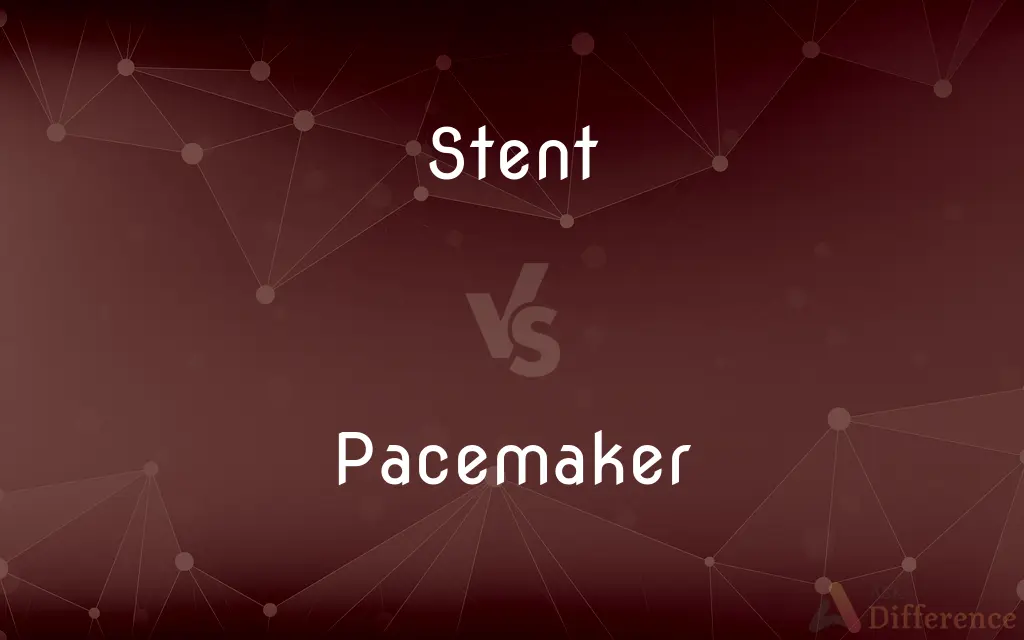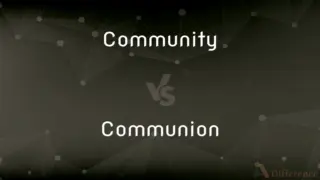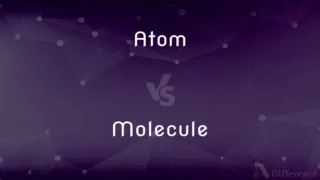Stent vs. Pacemaker — What's the Difference?
Edited by Tayyaba Rehman — By Fiza Rafique — Updated on September 30, 2023
A stent is a tube inserted into narrowed vessels to keep them open. A pacemaker is a device regulating heartbeats. Both assist the cardiovascular system but serve different functions.

Difference Between Stent and Pacemaker
Table of Contents
ADVERTISEMENT
Key Differences
A stent is a tiny, expandable mesh tube that doctors implant into narrowed or weakened arteries to ensure they remain open and facilitate blood flow. Conversely, a pacemaker is an electronic device implanted under the skin to help control or regulate abnormal heart rhythms by sending electrical pulses to the heart.
Stents primarily address issues related to blood flow blockages, such as those seen in coronary artery disease. They act as scaffolds, propping open the vessel. On the other hand, pacemakers intervene in heart rhythm disorders, ensuring the heart maintains an appropriate rate and rhythm.
The insertion of a stent is typically accomplished using a catheter threaded through the blood vessels. This is a less invasive procedure. In contrast, pacemakers require surgical insertion beneath the skin near the collarbone, involving more extensive preparation and aftercare.
Comparison Chart
Primary Function
Keeps narrowed vessels open
Regulates heart rhythms
Application
Addressing blood flow blockages
Addressing heart rhythm disorders
ADVERTISEMENT
Procedure Type
Less invasive catheter-based
Surgical insertion
Longevity
Indefinite
5-15 years (battery replacement needed)
Physical Form
Tiny, expandable mesh tube
Electronic device
Compare with Definitions
Stent
A scaffold for arteries.
With the stent in place, blood flow improved.
Pacemaker
A tool addressing heartbeat irregularities.
The pacemaker ensured her heart maintained a steady rhythm.
Stent
A tube to keep vessels open.
The doctor inserted a stent to alleviate the blockage.
Pacemaker
Battery-operated device for the heart.
The pacemaker battery typically lasts about 10 years.
Stent
Device for preventing vessel collapse.
A stent can mitigate risks of a heart attack.
Pacemaker
A device controlling heart rhythms.
Her heart rate stabilized after the pacemaker was implanted.
Stent
Treatment for artery narrowing.
The patient needed a stent for his coronary artery.
Pacemaker
Electronic aid for heart disorders.
With a pacemaker, his heartbeats became regular.
Stent
A meshed tube aiding blood flow.
The procedure involved placing a stent in the clogged vessel.
Pacemaker
A rhythm-regulating heart device.
Doctors recommended a pacemaker for his arrhythmia.
Stent
In medicine, a stent is a metal or plastic tube inserted into the lumen of an anatomic vessel or duct to keep the passageway open, and stenting is the placement of a stent. There is a wide variety of stents used for different purposes, from expandable coronary, vascular and biliary stents, to simple plastic stents used to allow the flow of urine between kidney and bladder.
Pacemaker
(Sports) One who sets the pace in a race. Also called pacer, pacesetter.
Stent
A splint placed temporarily inside a duct, canal, or blood vessel to aid healing or relieve an obstruction.
Pacemaker
A leader in a field
The fashion house that is the pacemaker. Also called pacesetter.
Stent
A substance used in dentistry for taking impressions of the teeth.
Pacemaker
A part of the body, such as the mass of muscle fibers of the sinoatrial node, that sets the pace or rhythm of physiological activity.
Stent
An assessment of property made for purposes of taxation
It was recorded in the stent book
Pacemaker
Any of several usually miniaturized and surgically implanted electronic devices used to stimulate or regulate contractions of the heart muscle.
Stent
Assess and charge (a person or a community) for purposes of taxation
Stent the Parish of Kildaltan in the ascertained sum
Pacemaker
One who sets the pace in a race, to guide the others.
Stent
A device used to support a bodily orifice or cavity during skin grafting or to immobilize a skin graft following placement.
Pacemaker
(anatomy) A set of nerves which stimulate the heart to beat.
Stent
A short tubular device made of wire mesh or fabric that is placed permanently in an anatomical passage, usually an artery during angioplasty, to keep it open after occlusion.
Pacemaker
A medical implement that is used to stimulate a heart to beat by simulating the action of the natural pacemaker.
Stent
A slender tube inserted into a blood vessel, a ureter or the oesophagus in order to provide support and to prevent disease-induced closure.
Pacemaker
A specialized bit of heart tissue that controls the heartbeat.
Stent
(archaic) An allotted portion; a stint.
Pacemaker
An implanted electronic device that takes over the function of the natural cardiac pacemaker{1}; - used to assist people whose heartbeat is irregular.
Stent
(medicine) To insert a stent or tube into a blood vessel.
Pacemaker
A horse used to set the pace in racing.
Stent
(archaic) To keep within limits; to restrain; to cause to stop, or cease; to stint.
Pacemaker
A leading instance in its field;
The new policy will be a pacesetter in community relations
Stent
(archaic) To stint; to stop; to cease.
Pacemaker
A specialized bit of heart tissue that controls the heartbeat
Stent
To keep within limits; to restrain; to cause to stop, or cease; to stint.
Then would he weep, he might not be stent.
Yet n'ould she stentHer bitter railing and foul revilement.
Pacemaker
An implanted electronic device that takes over the function of the natural cardiac pacemaker
Stent
To stint; to stop; to cease.
And of this cry they would never stenten.
Pacemaker
A horse used to set the pace in racing
Stent
An allotted portion; a stint.
Stent
A slender tube inserted inside a tubular body part (as a blood vessel) to provide support during and after surgical anastomosis
Common Curiosities
Is stent placement a major surgery?
No, stents are typically inserted using a less invasive catheter-based procedure.
Can stents be removed?
Stents are designed to remain in the body indefinitely and typically aren't removed.
Where is a pacemaker positioned in the body?
A pacemaker is implanted beneath the skin, near the collarbone.
How often do pacemaker batteries need changing?
Usually between 5-15 years, depending on usage and type.
Can one exercise with a pacemaker?
Yes, but it's essential to consult with a doctor about activity levels.
Can one undergo MRI with a stent?
Most modern stents are MRI-safe, but always consult a doctor.
How do doctors diagnose the need for a pacemaker?
Through tests like electrocardiograms or Holter monitoring which track heart rhythms.
What's the main purpose of a stent?
A stent keeps narrowed or weakened vessels open to improve blood flow.
How does a pacemaker function?
A pacemaker sends electrical pulses to regulate heart rhythms.
What materials are stents made from?
Stents can be made from metal mesh and sometimes are coated with medication.
Can stents cause complications?
Yes, like blood clots or artery re-narrowing, though these risks are relatively low.
What conditions might necessitate a stent?
Conditions like coronary artery disease where blood vessels become narrowed or blocked.
Do pacemakers require regular check-ups?
Yes, pacemakers need periodic monitoring to ensure they function correctly.
Share Your Discovery

Previous Comparison
Community vs. Communion
Next Comparison
Atom vs. MoleculeAuthor Spotlight
Written by
Fiza RafiqueFiza Rafique is a skilled content writer at AskDifference.com, where she meticulously refines and enhances written pieces. Drawing from her vast editorial expertise, Fiza ensures clarity, accuracy, and precision in every article. Passionate about language, she continually seeks to elevate the quality of content for readers worldwide.
Edited by
Tayyaba RehmanTayyaba Rehman is a distinguished writer, currently serving as a primary contributor to askdifference.com. As a researcher in semantics and etymology, Tayyaba's passion for the complexity of languages and their distinctions has found a perfect home on the platform. Tayyaba delves into the intricacies of language, distinguishing between commonly confused words and phrases, thereby providing clarity for readers worldwide.
















































